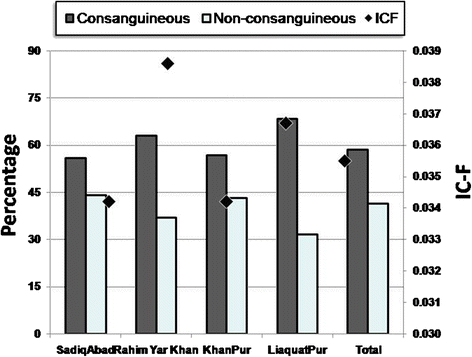Consanguinity and its socio-biological parameters in Rahim Yar Khan District, Southern Punjab, Pakistan
- PMID: 27206989
- PMCID: PMC5026024
- DOI: 10.1186/s41043-016-0049-x
Consanguinity and its socio-biological parameters in Rahim Yar Khan District, Southern Punjab, Pakistan
Abstract
Background: Rahim Yar Khan (RYK) District is a multi-ethnic assemblage of both ancient and migrated communities in Southern Punjab, Pakistan. There is a paucity of knowledge on the bio-demographic structure of this endogamous population.
Methods: We have carried out a cross-sectional epidemiological study in RYK District and recruited 2174 random Muslim married females. Detailed account of marital union types, level of consanguinity, and subject's fertility, was taken.
Results: The analyses of these data revealed that consanguineous unions (CU) were 58.46 %, rendering an inbreeding coefficient (IC-F) = 0.0355. The CU were observed to be significantly higher in subjects originating from rural areas, speaking Saraiki language, illiterate or having a religious/Madarsa education only, and belonging to nuclear family type. The rate of consanguinity was also higher in subjects whose husbands were engaged in unskilled manual or skilled manual jobs, and had consanguinity in the parental generation. Multivariate logistic regression analyses revealed that variables like Saraiki language, illiteracy, reciprocal marriages, and parental consanguinity, were the significant predictors of CU in the subject. Among the first cousin unions (which constituted 52 % of all marriages), parallel-cousin and patrilineal unions were in the majority (54 and 57 %, respectively), and father's brother's daughter type had the highest representation (31 %). The analyses further demonstrated that fertility and mean live-births were significantly higher in women who had CU compared to the non-consanguineous (NCU) group (p < 0.006); and significantly higher number of sons per women were born to the mothers who had CU compared with the NCU sample (p = 0.0002). However, there were no differences in the CU and NCU samples with respect to pre- or post-natal mortalities and child morbidities.
Conclusions: The scientific findings in RYK District are distinct from the observations in other Pakistani populations and clue to a unique nature of this population. This study presents a comprehensive account of consanguinity and IC-F in RYK District and would be helpful in getting an insight into the structure of this population.
Keywords: Child morbidity; Child mortality; Consanguinity; Fertility; Genetic epidemiology; Inbreeding coefficient; Pakistan; Rahim Yar Khan; Sex ratio; Southern Punjab.
Figures


Similar articles
-
Consanguinity, inbreeding coefficient, fertility and birth-outcome in population of Okara district, Pakistan.Pak J Med Sci. 2021 May-Jun;37(3):770-775. doi: 10.12669/pjms.37.3.2263. Pak J Med Sci. 2021. PMID: 34104163 Free PMC article.
-
PATTERN OF CONSANGUINITY AND INBREEDING COEFFICIENT IN SARGODHA DISTRICT, PUNJAB, PAKISTAN.J Biosoc Sci. 2015 Nov;47(6):803-11. doi: 10.1017/S0021932014000431. Epub 2014 Oct 9. J Biosoc Sci. 2015. PMID: 25299747
-
Consanguinity as a determinant of reproductive behaviour and mortality in Pakistan.Int J Epidemiol. 1993 Jun;22(3):463-7. doi: 10.1093/ije/22.3.463. Int J Epidemiol. 1993. PMID: 8359962
-
Assessment of association between consanguinity and fertility in Asian populations.J Health Popul Nutr. 2004 Mar;22(1):1-12. J Health Popul Nutr. 2004. PMID: 15190806 Review.
-
The effect of religious, cultural and social identity on population genetic structure among Muslims in Pakistan.Ann Hum Biol. 2005 Mar-Apr;32(2):145-53. doi: 10.1080/03014460500075167. Ann Hum Biol. 2005. PMID: 16096210 Review.
Cited by
-
Clinical and genetic attributes of congenital anomalies ascertained at a tertiary care hospital in Rawalpindi, Pakistan.Pak J Med Sci. 2023 Nov-Dec;39(6):1673-1679. doi: 10.12669/pjms.39.6.7408. Pak J Med Sci. 2023. PMID: 37936764 Free PMC article.
-
Sociodemographic Factors and Awareness of Consanguineous Marriages in Rural Northern Karnataka: A Cross-Sectional Study.Cureus. 2024 Dec 25;16(12):e76376. doi: 10.7759/cureus.76376. eCollection 2024 Dec. Cureus. 2024. PMID: 39867089 Free PMC article.
-
Analyzing Inbreeding and Estimating Its Related Deficiencies in Northeastern Brazil.J Pediatr Genet. 2021 Apr 1;11(4):272-278. doi: 10.1055/s-0041-1725977. eCollection 2022 Dec. J Pediatr Genet. 2021. PMID: 36267866 Free PMC article.
-
Burden of congenital and hereditary anomalies and their epidemiological attributes in the pediatric and adult population of Peshawar valley, Pakistan.Pak J Med Sci. 2024 Nov;40(10):2181-2189. doi: 10.12669/pjms.40.10.9234. Pak J Med Sci. 2024. PMID: 39554678 Free PMC article.
-
Congenital limb defects in a married female population of the Rahim Yar Khan District in Pakistan.Asian Biomed (Res Rev News). 2021 Jun 30;15(3):137-144. doi: 10.2478/abm-2021-0017. eCollection 2021 Jun. Asian Biomed (Res Rev News). 2021. PMID: 37551370 Free PMC article.
References
-
- Bittles AH. Consanguinity, genetic drift, and genetic diseases in populations with reduced numbers of founders. In: Speicher MR, Antonarakis SE, Motulsky AG, editors. Vogel and Motulsky’s Human Genetics. Springer-Verlag.: Berlin Heidelberg; 2010. pp. 507–728.
-
- Woods CG, Cox J, Springell K, Cox J, Springell K, Hampshire DJ, Mohamed MD, McKibbin M, Stern R, Raymond FL, Sandford R, Malik Sharif S, Karbani G, Ahmed M, Bond J, Clayton D, Inglehearn CF. Quantification of homozygosity in consanguineous individuals with autosomal recessive disease. Am J Hum Genet. 2006;78:889–96. doi: 10.1086/503875. - DOI - PMC - PubMed
-
- Bittles AH. The role and significance of consanguinity as a demographic variable. Pop Dev Rev. 1994;20:561–84. doi: 10.2307/2137601. - DOI
Publication types
MeSH terms
LinkOut - more resources
Full Text Sources
Other Literature Sources
Medical

